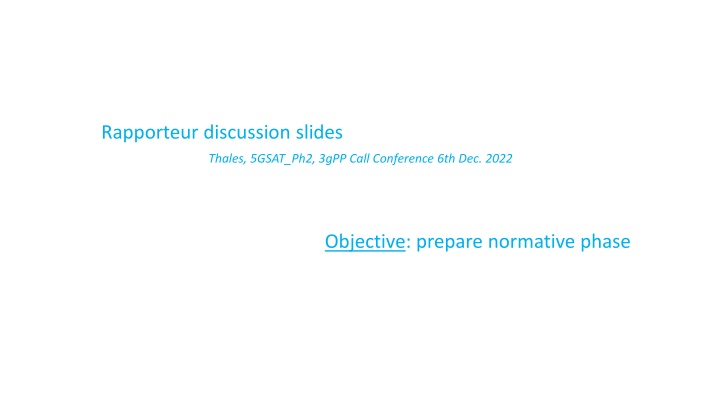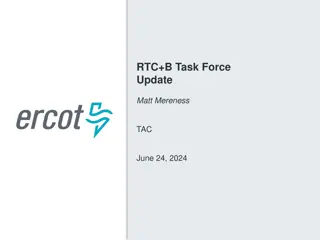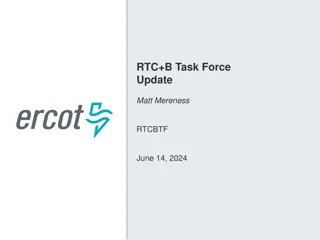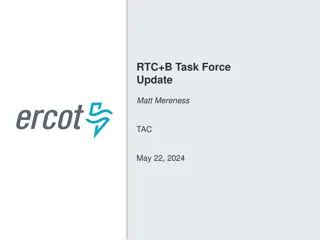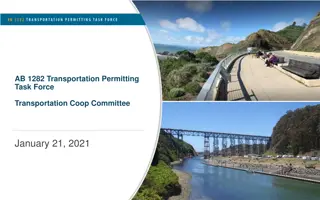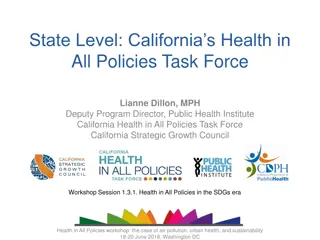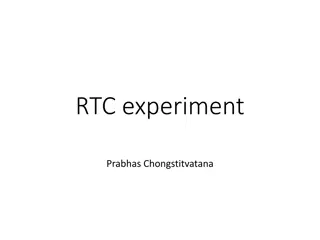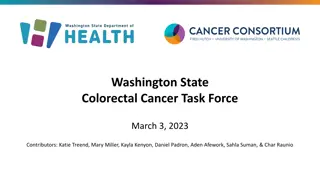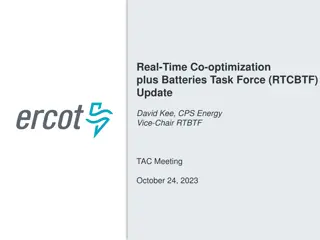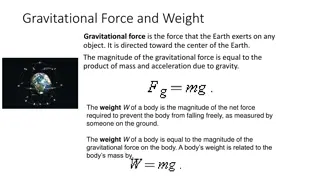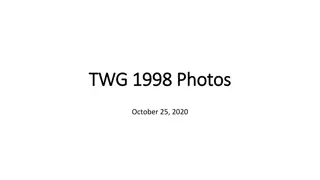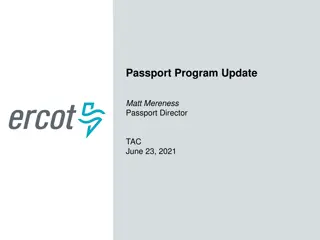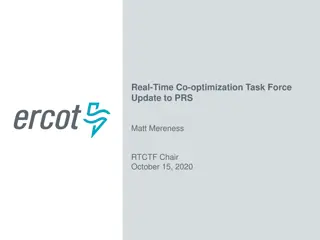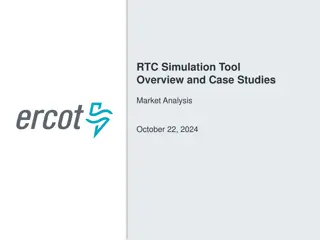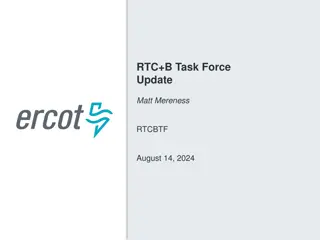RTC+B Task Force Update by Matt Mereness TWG
Program update including current issues review, program excerpt, market trial dates, QSE scorecards, and trial phase criteria. Details on RTC+B Program scope, revision requests, program revisions, and market submission requirements.
Download Presentation

Please find below an Image/Link to download the presentation.
The content on the website is provided AS IS for your information and personal use only. It may not be sold, licensed, or shared on other websites without obtaining consent from the author.If you encounter any issues during the download, it is possible that the publisher has removed the file from their server.
You are allowed to download the files provided on this website for personal or commercial use, subject to the condition that they are used lawfully. All files are the property of their respective owners.
The content on the website is provided AS IS for your information and personal use only. It may not be sold, licensed, or shared on other websites without obtaining consent from the author.
E N D
Presentation Transcript
Rapporteur discussion slides Thales, 5GSAT_Ph2, 3gPP Call Conference 6th Dec. 2022 Objective: prepare normative phase
Where we are for satellite access Ph2? FS_5GSAT_Ph2 100% completed, thank s all for the good job here! December SA: WID approved by email process after Toulouse and presented to SA#98 in SP-221132 CoverSheet for TR v2.0.0 approval in SA presented by SA2 is SP-221097, with editorial issue in 8.3 Rapporteurs present in SP-221198 coversheet for TR v2.1.0 to remove EN in 8.3 (solve editorial issue). Normative phase Current hypothesis is that we do have 2 meetings, January SA2#154 AdHoc-e and Athenes Feb SA2#155, with 0.5 TU each, to complete the normative phase for DisCo (Discontinuous Coverage) for EPC & 5GC Rapporteur s comment: we let the door open to complete the solutions panel in last August meeting and the we got very complete range of possible solutions. That s good. Counterpart is that we had to complete the study in 2 meeting. We succeeded thanks' to very collaborative mindset of all to determine the system architecture we want, and now we have to well prepare the 2 coming meetings to optimize our TUs to finalize the specifications!
Reminder on Study conclusions(1) Conclusion on general mobility management and/or power saving (1) Principles of system behaviour: NTN MEO/LEO satellite or satellite constellation that provides discontinuous coverage is considered as the satellite access in 5GS and EPS for the power saving enhancement and UE unreachability period can be provided to both the UE and AMF/MME. UE unreachability period provided to the UE and/or AMF/MME shall include either timing information when UE moves out/in of NTN coverage or information on satellite coverage at current and potential future locations of the UE. Both network centric and UE centric procedures are used to determine and coordinate the UE unreachability period. These two approaches are not mutually exclusive, they serve different use cases and they can co-exist in the same network. In Network centric procedure, the AMF/MME determines the PSM parameters taking into account the UE unreachability period. In UE centric procedure, the UE informs the network about UE determined UE unreachability period and/or an indication when leaving/entering coverage. AMF/MME information retrieval: AMF/MME shall not determine UE unreachability period based on satellite orbit data by itself. The AMF/MME receives UE unreachability period to be used for setting up the power saving parameters or handling mobility management of NTN UE. AMF/MME obtains UE unreachability period information (timing information when UE moves out/in of NTN coverage) from an AF via the NEF/SCEF, from the UE or from OAM. The AMF/MME also takes into account UE location/mobility/trajectory information.
Reminder on Study conclusions(2) Conclusion on general mobility management and/or power saving(2) The role of AMF/MME: The AMF/MME configures the UEs mobility management and Power saving mode (PSM) parameters and sends the MICO/PSM parameters to UE before the satellite discontinuous coverage starts. Takes into account the UE unreachability period in order to make sure the UE is in power saving mode if it is leaving network coverage, to avoid attempting to page the UE during this time and that the UE need not initiate NAS procedures excessively frequently compared to the Expected UE behavior, if known by the AMF/MME. The mobility management and MICO/PSM parameters include: Periodic registration update timer / Periodic TAU Timer, MICO mode with optional Active Time and PS, MICO mode with Extended Connected time (only for AMF case), eDRX parameters. AMF/MME takes the Tracking Area reported by RAN before AN release as the paging area. The AMF/MME sets an implicit detach timer based on the UE unreachability period information to avoid de-registering or detaching the UE when it is in discontinuous coverage. NOTE: Whether the UE can be in CM-connected with RRC inactive and the AN release procedure is needed when there is no satellite coverage can be discussed during the normative phase. Optionally, AMF can provide a backoff timer to prevent the UE from sending MO data/signalling while out of coverage. Request the UE to inform AMF/MME about when UE unreachability periods begin and end.
Reminder on Study conclusions(3) Conclusion on general mobility management and/or power saving(3) Regarding which information UE has and how UE retrieves it: If possible, accurate UE coverage information is shared with UE, i.e. UE coverage information received from the network with enhanced solution compared to Rel-17. Satellite coverage data may be transferred to a UE from an external server or an AF. Following Rel-17, the UE has satellite assistance information for predication of discontinuous coverage from RAN broadcasts. Editor's note: LS need to have feedback from CT1 on whether UP or NAS via an AMF/MME (CP) will be used for the transfer depends on the discussion. Regarding the role of the UE: The capability for the UE to be able to determine requested NAS timer values and MICO/PSM parameters based on its predicted UE unreachability periods needs to be specified. A UE that uses power saving initiates a NAS procedure, with sufficient time to complete the NAS procedure before the start of the unreachability period, and negotiates timer values and power saving parameters with AMF/MME as per existing specifications.
Reminder on Study conclusions(4) Conclusion on overload impacts to a target RAT/PLMN The following aspects are concluded for normative work: MEO/LEO providing quasi-static fixed earth footprint with steerable beams is considered as the satellite type that needs the signalling overload control due to their insufficient randomization compared to MEO/LEO that provides earth moving coverage. AMF determines the "wait range" based on network configuration and sends the "wait range" to the UE via the Registration procedure or UE Configuration Update procedure. The "wait range" configuration value should take care that higher priority users are given better priority than normal UEs. NOTE 1: Whether to use the same parameter as in MINT or to define new parameter for satellite discontinuous coverage, will be determined during normative phase. The UE calculates the "wait timer" based on "wait range" configuration from the network and starts the respective "wait timer" when returning to coverage after being in discontinuous coverage: NOTE 2: Whether to apply wait timer if the UE selects other RAT/PLMN to continue the service due to discontinuous coverage can be discussed during normative phase. If the UE has to remain in no service (e.g. by applying power saving) due to discontinuous coverage and waits until the same RAT/PLMN coverage returns, the UE will calculate the "wait timer" (e.g. by selecting a random value between 0 and "wait range") to reduce signalling overload on the same RAT/PLMN. The UE will not initiate any NAS signalling to the target system when the "wait timer" is running.
Network centric approach representation (5G case) MNO domain OAM CP Case 1 AF Case 2 NEF AMF SBA/SBI N1 UE gNB N2(N1) Legend -> generation of coverage information based unreachability period for positions/times in relation with Satellite Network Center 1. Based on ephemeris, calculate where the constellation will have coverage and at what times. I.e. go from ephemeris to a coverage map . 2. Based on coverage map, determine the times when certain locations (current and future UE location) will have coverage. I.e. go from a map to actual coverage times for a given UE s location + trajectory. -> transfer of coverage information based unreachability period on given interface -> Specific (taking DisCo in account) configuration of the UEs mobility management and Power saving mode (MICO/PSM) parameters. AMF/MME also takes into account UE location/mobility/trajectory information.
UE centric approach representation (5G case) AMF N1 Request the UE to inform AMF/MME about when UE unreachability periods begin and end. UE gNB N2(N1) N3 UPF AF N6 UP Legend -> generation of coverage information based unreachability period for positions/times in relation with Satellite Network Center 1. Based on ephemeris, calculate where the constellation will have coverage and at what times. I.e. go from ephemeris to a coverage map . -> transfer of coverage map information on given interface -> transfer of coverage information based unreachability period on given interface 1- Based on coverage map, determine the times when certain locations (current and future UE location) will have coverage. I.e. go from a map to actual coverage times for a given UE s location + trajectory. 2- UE determines requested NAS timer values and MICO/PSM parameters based on obtained predicted UE unreachability periods 3 - transmits unreachability period to AMF
Open points (1) Open points (1) CT1 feedback to SA2: Available information, cf C1-227196 (Reply LS on Satellite coverage data transfer to a UE using UP versus CP), agreed in Toulouse: CT1 would like to thank SA2 for their LS on Satellite coverage data transfer to a UE using UP versus CP. Overall, CT1 could in principle provide a stage 3 solution for stage 2 normative requirements to support transfer of coverage map data to a UE for one or more satellite RATs using either a control plane or a user plane transfer. CT1 has designed both CP and UP protocols for various features in the past. Control plane data transfer via NAS is used for power-efficient, relatively infrequent transfers of small amounts of data, that do not require protocol functions like packet numbering, in- sequence delivery, and acknowledgments to be provided by the NAS transfer (depending on the protocol endpoint in the 5GS, these protocol functions may be provided by the RDS protocol, see TS 24.250). It also requires a 5GC entity to be the other endpoint of the coverage map data transfer. For a control plane solution via NAS, the coverage data could be provided either via transparent containers or via defined NAS IE(s). For transfers of more frequent and/or larger amounts of data, for data that originates from external servers, and/or if the above protocol functions are needed to be provided along with the transfer, a user plane option is usually more suitable. Subscription and charging are out of the scope of CT1 expertise. In order to provide a more detailed evaluation of the feasibility of the CP and the UP option, the CT1 would require more information about the requirements for the coverage map data transfer, including but not limited to: expected payload size, the contents of coverage map data, the target layer in the UE and the expected frequency of coverage map data updates.
Open points (2) Open points (2) Articulation between Network centric and UE centric approach for unreacheability period determination Rapporteur s comment/proposal: CT1 feedbacks that Control plane data transfer via NAS is used for power-efficient, relatively infrequent transfers of small amounts of data and that It also requires a 5GC entity to be the other endpoint of the coverage map data transfer . These characteristics could be coherent with the use of UE centric approach in case of UE with limited resources (e.g: IoT devices). In the other hand, CT1 state that For transfers of more frequent and/or larger amounts of data, for data that originates from external servers, and/or if the above protocol functions are needed to be provided along with the transfer, a user plane option is usually more suitable These characteristics could be coherent with the use of UE centric approach in case of UE with less limited resources (e.g: smartphones). => 3 cases are then possible: - C1: Network centric case - C2: UE centric case with reduced coverage map info over CP for UE with limited resources - C3: UE centric case with full coverage map info over UP for UE with less limited resources
Open points ( Open points (recap note: not exhaustive, to exchange on/ note: not exhaustive, to exchange on/evaluate recap) ) evaluate the the work work to to be be done done Propose CR(s) to articulate C1, C2, C3 Provide LS response to CT1 together with requested requirements for coverage data map transfer, e.g: : expected payload size, the contents of coverage map data, the target layer in the UE and the expected frequency of coverage map data updates Propose CR(s) for network centric approach. To be considered: What are data and procedures on AMF/NEF interface, AMF behavior What are data and procedures on MME/SCEF interface, MME behavior How AMF/MME retrieves UE location/mobility/trajectory information. Propose CR(s) for UE centric approach To be considered: Coverage map information retrieval and UE behavior Transmission of Unreachability period to AMF Transmission of Unreachability period to MME Propose CR(s) for wait range/wait timer mechanisms
